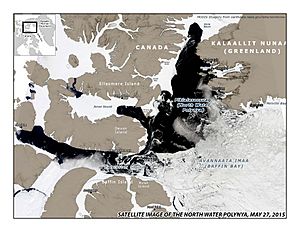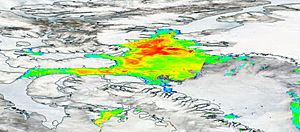North Water Polynya facts for kids
The North Water Polynya is a very special area of open water in the ocean. It stays unfrozen all year, even when the sea around it is covered in thick ice. This amazing place is located between Greenland and Canada in northern Baffin Bay.
Local Inuit people have their own names for it: Pikialasorsuaq in Greenland and Sarvarjuaq in Canada. It's the largest Arctic polynya, covering about 85,000 square kilometers. That's a huge area!
This polynya creates a warm, unique environment. It's like a safe haven for many animals, including narwhals, belugas, walruses, and bowhead whales. They come here to find food and rest. Even though some thin ice might form, strong winds, ocean tides, and an "ice bridge" to its north help keep the North Water open.
Whalers in the 1800s called it the "North Water" because it was a clear path for their ships in spring. Today, we know it's one of the most important and productive marine areas in the entire Arctic Ocean.
Contents
Animals of the North Water Polynya
Polynyas are often called "oases" in the frozen Arctic. This is because their open waters allow tiny ocean plants, called plankton, to grow much earlier in the spring. This early growth provides a lot of food for other creatures.
One very important fish here is the Arctic cod. These fish are a key food source for almost all the other animals in this ecosystem. Many large marine mammals, like walruses, seals, and even polar bears, gather at the edge of the ice to feed. They stay there until the ice breaks up in spring.
The North Water also provides vital feeding grounds for millions of seabirds. This includes about two-thirds of the world's population of little auks (also called dovekies) and thick-billed murres. It's a busy and lively place!
Human History and the North Water
This region has been home to people for at least 5,000 years. Ancient cultures like the Dorset and Thule lived here. Today, Inuit communities in Canada (Nunavut) and Avanersuaq (Greenland) still rely on the polynya. The many marine mammals found here help them keep their traditional way of life.
The North Water is surrounded by some of the northernmost human settlements in the world. These include the Canadian Inuit communities of Arctic Bay, Pond Inlet, and Grise Fiord. The Inuit people depend on the rich marine life of the North Water for their food, clothing, shelter, and their cultural and economic well-being.
There's even evidence that Vikings from southern Greenland visited the North Water in the 1200s. Later, in 1616, a ship called the Discovery sailed into this area. Its captain, Robert Bylot, and pilot, William Baffin, named many landmarks. For example, Smith Sound was once called Sir Thomas Smith's Bay. From the 1400s to the 1800s, European whalers came here. They hunted bowhead whales so much that these whales almost disappeared.
Scientific Research in the Arctic
Since 1867, the North Water ecosystem has been a popular place for scientists to study. They want to learn the secrets of Arctic polynyas, including how ocean currents work and what kinds of life thrive there.
Researchers also study how this region is reacting to global climate change. The Arctic ecosystem is warming twice as fast as the rest of the world. This makes the North Water a very important place to understand these changes.
How the North Water Stays Open
The North Water Polynya is closely connected to Lancaster Sound and Baffin Bay. Powerful ocean currents flow through these areas. These currents directly affect the region's climate and its biology. The North Water polynya is actually formed by three smaller polynyas joining together: Smith Sound, Lady Ann Strait, and Lancaster Sound.
A current called the West Greenland Current flows along Greenland's coast. It brings warm, salty water from the Atlantic Ocean north, all the way to the North Water Polynya. This warmer water rises up in the polynya, helping to keep it partly ice-free all year. This happens even when the ocean directly north and south is frozen solid. Another part of the West Greenland Current also flows into Lancaster Sound. This brings Atlantic waters into the Arctic Ocean, which helps create a rich environment for many animals there too.
Protecting the North Water
The land next to the North Water is already recognized as very important. In 1974, Denmark created Northeast Greenland National Park. It's the world's largest national park. In 1977, it became an international biosphere reserve. Similarly, Canada created Quttinirpaaq National Park in 1988 on Ellesmere Island. This is Canada's second largest national park.
While a good portion of the world's land is protected, only a small part of the global ocean is. The waters of the North Water polynya do not yet have formal protection. This is especially important now, as there is more industrial activity happening in the Arctic.
In 1982, the western waters of Lancaster Sound were named one of the 188 greatest natural areas in the world. It was one of the few Arctic sites to get this recognition. However, these areas in Lancaster Sound still don't have national or provincial protection.
There are currently no World Heritage Sites above the 73rd parallel north. At a meeting in 2012, the International Union for the Conservation of Nature (IUCN) was asked to support local communities in managing marine protected areas.
In April 2016, a special group called the Pikialaorsuaq Commission started gathering ideas from people in the High Arctic communities of Canada and Greenland. They wanted to know how to best protect the North Water Polynya in the future. In April 2017, a Canadian report suggested that Canada should accept the Commission's idea. This idea was to create an Inuit-led plan to manage and monitor the entire North Water Polynya. It also suggested recognizing the region as an Indigenous Protected Area (IPA).



